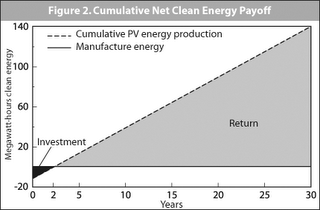Electric Cars and Photovoltaic Solar Cells
Question: How many solar panels do I need to power my Tesla Roadster?I didn't realize that you only needed 10 square meters of solar cells to allow for 12,000 miles of driving a year. That seems very doable. If we were to power cars with cellulosic ethanol instead it would require 32 times more land.Martin: The Tesla Roadster consumes about 200 watt-hours per mile. Suppose you drove 35 miles per day on average (12,775 miles per year). You would need to generate 2.6 MWh/year.
By Elon’s math, monocrystalline solar panels generate about 263 kWh/m2/year in the USA. So you would need about 9.7 square meters of solar panels (a square about 10 feet on a side) to completely offset the energy consumed by your Tesla Roadster.

Question: Doesn’t it take more energy to produce a solar panel than that panel will ever produce in its serviceable life?Another way to think about this is that about 10% of the energy generated by the solar cells over their lifetime is needed to produce them. So, you need an extra 10% of solar cells to take care of the production energy. Instead of 10 square meters to power your car, you really need 11 to take into account the energy needed to produce the solar cells.In a modern manufacturing plant, the energy needed to create a frameless PV module from semiconductor scrap material is estimated to be around 600 kWh/m2 for monocrystalline cells and 420 kWh/m2 for multicrystalline cells (source: www.nrel.gov). A big variable is how thin the silicon wafer can be sliced. For ultra-thin cells, like those from Sunpower, the energy to produce a module may be considerably lower.
Taking the monocrystalline example:
Solar incidence (US): 1825 kWh/m2/year Module efficiency: 18% (Sunpower) Energy lost in system: 20% (Due to inverter, wires, cell temperature, etc.) Energy to create module: 600 kWh/m2 (National Renewable Energy Lab.) … to build aluminum frame: 80 kWh/m2 (from Alsema et al)
The above results in a payback period of roughly 2 and a half years. The NREL study similarly calculates the payback period for polycrystalline panels to be 3-5 years, and amorphous silicon panels to be 0.5-2 years. Given that most modules have a 25 year warranty and an expected useful life in excess of 30 years, this indicates about a ten to one advantage for energy generated versus consumed.
via Tesla Motors Blog





3 comments:
ok, I understand all of that, but I'm still a little confused
Do those calculations take into account:
The physical degradation of the panel-and the resulting lower energy production-due to exposure to UV rays and the elements?
I love the idea of converting to the use of solar panels, but is the cost worth the output?
do you know of any good sources fo more info like this?
kdev,
I don't know if the calculations take into account the physical degradation of the panel-and the resulting lower energy production-due to exposure to UV rays and the elements. I'm not even sure how big that impact is.
As for whether the cost of solar is justified, it really depends on what you are taking into account. For a consumer just looking at the costs they have to pay, no, at this point coal based electricity and gasoline powered cars are cheaper. But if you take into account externalities such as climate change and the impact of oil (both on countries that need access and those that sell it) then I think you can make a case that it does.
Solar will be coming down in price for the foreseeable future, so there is also the question of whether to buy now or wait a few more years (just like with any technology). Personally I think that solar is the long term future of energy (with smaller portions provided by wind and geothermal) and any purchases now help to fund research and development that will help make the day when solar is everywhere that much sooner.
As for other good sources of information, take a look at the all my posts with the solar tag and follow the links in them. You should be able to find some good sources there.
This analysis is missing a lot of parameters, just as an example
- how much energy you need to produce the batteries (which you need to change every 6-7 years)?
- if you use your car, the car will not be staying next to your solar pannels during daylight time, so you will need batteries to store the energy produced by the solar pannels, and this will lead to a power loss, plus you will have to think about the engery to produce those batteries again.
- 0.2 KWh per mile is really understated, the truth for a tesla should be 0.5-0.6, which is 3 times more!
- Finally, you should also consider that your solar pannel must cover not the average consumption but your maximum consumption: if you use your car only 3 days in a row per week and drive 70 miles, you need from day 1 to day 2 to refill enough energy for 70 Miles.
- Same issue about the average for the time in the year: you use your car in cloudy days as well as in bright sunny days, so you will need a lot of batteries or a lot of solar pannels to cover your real life needs.
So in real life, I think you will end up with a need of 150-200 Square meteres to cover the energy needed for your Tesla. Not far from the Ethanol model - which is much much cheaper in total.
Post a Comment
Note: Only a member of this blog may post a comment.